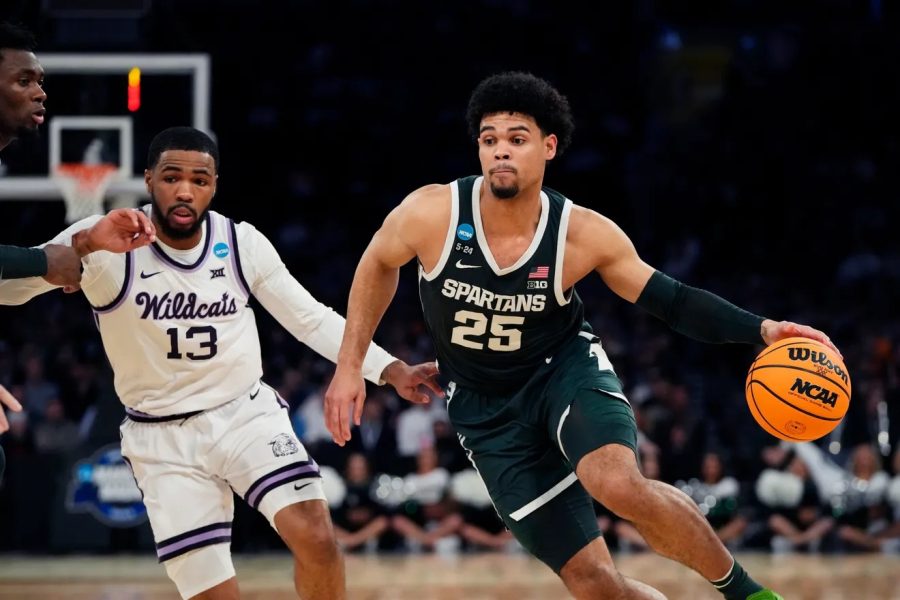Transfer Portal, Extra Eligibility Contributes to Unprecedented Results in March Madness
Photo courtesy of Frank Franklin II
Michigan State’s Malik Hall competes in a game against Kansas State.
There has been an interesting trend in college athletics since the COVID-19 pandemic. Prior to 2020, teams were typically composed of players aged 18–23, and many of the older athletes were fourth-years. Typically, athletes would only play for a fifth year if they lost a season due to injury or personal matters and had an extra season of eligibility. With this extra year also comes the chance to utilize the transfer portal, an opportunity for student athletes to switch schools. Historically, athletes would graduate from the school they started at, and transfer students were somewhat uncommon, especially in Division I athletics. Athletes’ bodies become much stronger as they age from their teens into their 20s, so teams that have more 22- and 23-year-old players on the court hold a significant advantage when facing teams with predominantly 18-year-old members.
The presence of more upperclassmen in many teams led to one of this year’s most shocking upsets in the Women’s March Madness bracket. For instance, for the first time in 14 years, Stanford University failed to advance to the Sweet 16. Mississippi, the No. 8 seed, upset the No. 1 seed Cardinals 54–49 in the second round. Although skill contributes to much of the differential in these games, age and size are factors as well. The Rebels’ roster this year was mostly made up of upperclassmen. Of the 12 athletes on the team, only two were underclassmen: one first-year and one redshirt second-year. In fact, there were as many graduate students as underclassmen. Of the seniors on the team, four out of the five were taking advantage of their extra year of COVID eligibility, which meant they were actually fifth-years. This age and strength disparity played a key role in the outcome of the game, with Ole Miss muscling away seven more offensive rebounds than Stanford.
The physical advantages of teams with more upperclassmen were on display in the men’s bracket as well. Heading into its Sweet 16 clash, Kansas State, the No. 3 seed, was favored against the No. 7 seed, Michigan State. KSU’s roster this year is made up of three first-years, three second- years, three third-years, and six seniors. Four of its starters were upperclassmen, and five of the six underclassmen had never seen the court.
On the flip side, underclassmen make up nearly half of Michigan State’s team, and, with the exclusion of one fourth-year and one graduate student, every player started their career with MSU. Michigan State openly refused to open its transfer portal, thus limiting the potential talent and age on its roster. Alternatively, Kansas State’s roster was mainly made up of transfer students, with only two students from the 2021–2022 school year returning to Kansas State for the 2022–2023 school year. Most transfer students are upperclassmen and thus bring a greater physical advantage.
This year’s March Madness has truly lived up to its name, and the seemingly constant upsets in both brackets are no fluke. On the men’s side, for the first time in history, no No. 1, 2, or 3 seeded team will be in the Final Four. Connecticut is the highest ranked team as a No. 4 seed, followed by Miami and San Diego State, who are both No. 5 seeds. The lowest seed and biggest shock of the tournament has been Florida Atlantic University, which has made it to the Final Four as a No. 9 seed. Only once in March Madness history has a No. 4 seed ever won — Arizona in 1997 — and a No. 5 seed and No. 9 seed have never hoisted college athletics’ most important trophy. On the women’s side, two of the four No. 1 seeds went out in the second round. Stanford and Indiana lost to Ole Miss and Miami, respectively, which opened the doors slightly for a lower-seeded team to make a breakthrough to the Final Four. However, Caitlin Clark and the No. 2 seed Iowa Hawkeyes saw their window of opportunity and took it, beating Georgia, Colorado, and Louisville on their way to their Final Four matchup with the outright favorite, the undefeated University of South Carolina Gamecocks.
On the other half of the bracket, No. 1 seed Virginia Tech has been clinical on its path to the Final Four, with its narrowest margin of victory coming at nine points against the No. 4 seed Tennessee. It faces No. 3 seed LSU, which is led by coaching powerhouse Kim Mulkey. Both women’s games will be played later tonight, followed by the men tomorrow. Overall, the transfer portal and eligibility rules have significantly altered the state of college athletics.
The results from this year’s March Madness are not out of the ordinary. They’re just a sign of what’s to come for the future of college athletics.




